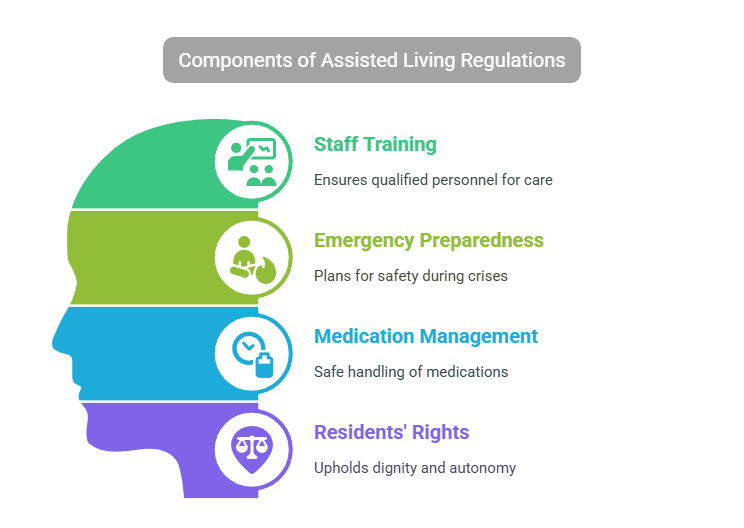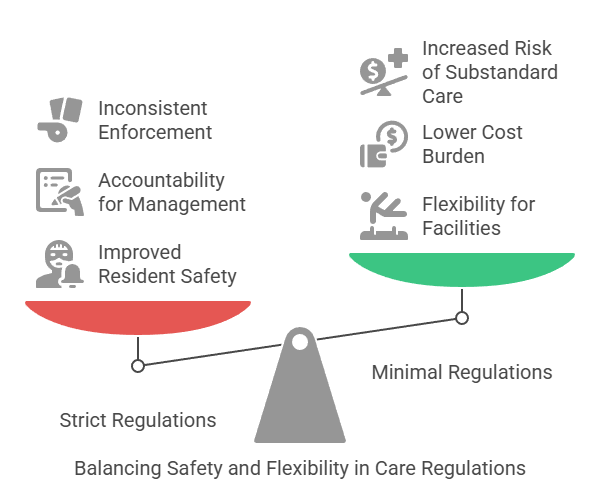 Back to
blogs
Back to
blogs

Assisted Living Regulations: What Families Should Know
Understanding assisted living regulations and resident rights.
Assisted living regulations are vital for families searching for the safest, most supportive environment for a loved one. With the growth of assisted living communities nationwide, understanding the legal standards, resident rights, and state oversight has never been more important. These regulations ensure quality care, protect residents from neglect or abuse, and help families make well-informed care decisions. In this guide, we explain the key regulations, show why they matter, and answer frequently asked questions to empower you in choosing the right assisted living environment.

Assisted living communities provide seniors with personalized care and daily support while maintaining independence. Because residents may be vulnerable due to age or health, various federal and state regulations exist to safeguard their well-being. These rules impact everything from staff training and emergency preparedness to medication management and residents’ rights.
Unlike nursing homes, which are primarily regulated at the federal level (by the Centers for Medicare & Medicaid Services - CMS), assisted living regulations are set and enforced mostly by individual states. Every state has its own licensing requirements, inspection schedules, and enforcement processes. However, many standards are consistent across states, such as those related to safety, food services, and resident rights.
While these requirements help ensure quality, families should familiarize themselves with specific state regulations and inspection histories of each community they consider.

| Pros | Cons | |
|---|---|---|
| Strict Regulations | - Improved resident safety - Accountability for facility management | - Higher operational costs for providers - Potential for inconsistent enforcement across states |
| Minimal Regulations | - Flexibility for facilities - Lower cost burden in some regions | - Increased risk of substandard care - Less oversight if issues arise |
| Feature | Assisted Living | Nursing Home | Independent Living |
|---|---|---|---|
| Monthly Cost (average) | $4,500–$6,000 | $7,000–$9,000 | $2,000–$4,000 |
| Regulatory Body | State Health Agencies | Federal (CMS) and State | Local/State |
| Care Level | Assistance with daily activities, medication support | Skilled nursing, 24/7 medical care | No health/personal care, focus on lifestyle |
| Resident Rights | Yes – defined by state | Yes – federally mandated | Varies |
Some states require transparency in pricing and contract terms; always request written documentation before signing agreements.
Q: What is assisted living regulations?
A: Assisted living regulations refer to a set of state-specific or federal standards that govern how assisted living communities operate, focused on resident protection, safety, staffing, and quality of care.
Q: How does it compare to alternatives?
A: Assisted living offers more independence and privacy than nursing homes, with care tailored to daily living needs, but less medical care. Regulations also differ, with nursing homes subject to stricter federal oversight.
Q: What are the typical costs?
A: Monthly costs for assisted living usually range from $4,500–$6,000, not including additional services. Costs vary by state, amenities, and specific care requirements.
Q: Is this option right for families?
A: Assisted living is a strong choice for seniors who need day-to-day help but don’t require intensive medical care. Understanding regulations helps families ensure their loved one’s rights and safety are protected.
Q: Are any services covered by insurance?
A: Traditional Medicare doesn’t cover assisted living, but some states offer waivers, and long-term care insurance may help offset costs.
Understanding assisted living regulations is essential when choosing a community for yourself or a loved one. These rules and standards provide a foundation for safety, freedom, and well-being. Always investigate your state’s specific requirements and a facility’s compliance record before making a final decision. Assisted Living Regulations: What Families Should Know plays a critical role in Assisted Living decisions. Explore our expert resources or visit National Institute on Aging for more insight.
Assisted living regulations refer to the standards and laws imposed—usually by state governments—that set the minimum operating requirements for assisted living facilities, covering areas such as safety, staffing, resident rights, and health protocols.
Nursing homes fall under federal regulation and offer more extensive medical care, while independent living is regulated less harshly and provides few health oversight standards. Assisted living regulations offer a balanced approach, focusing on daily support and safeguards.
Costs for assisted living vary by state, but typically range from $4,500–$6,000 per month, not including additional care, ancillaries, or private rooms.
If your loved one needs support with activities of daily living but not 24/7 medical care, and you want oversight and accountability safeguards, assisted living—with proper regulatory standards—can be an ideal fit.
Medicare does not typically cover assisted living costs, but some Medicaid programs and long-term care insurance policies may help with certain services. Always check state policies and insurance plans for specifics.